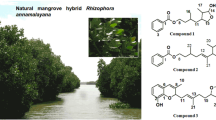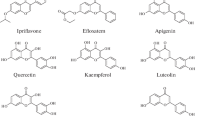Abstract
Previously undescribed chromenyl derivatives, characterized as 7-(2′-ethyl-1′-hydroxynonan-2′-yl)-6,7,8,8a-tetrahydro-3H-isochromen-1-(5H)-one (1) and 61-(3-((E)-31b-(furan-2′-yl)-prop-31b-en-31-yl)-4a,5,6,8a-tetrahydro-8-methyl-2H-chromen-6-yl)-ethyl-5′′-methyl-hexanoate (2) were isolated from ethyl acetate-methanol extract of yellow-foot bivalve clam, Paphia malabarica. Their structures have skeletons composed of isochromen-(5H)-one and furanyl-2H-chromenyl moieties, which are reported for the first time in marine organism. These were characterized by extensive one and two-dimensional nuclear magnetic resonance, infrared, and high-resolution mass spectroscopic experiments. The title compounds were evaluated for therapeutic potentials with regard to anti-inflammatory and antioxidant properties compared to known standards. These compounds exhibited comparable 2, 2-diphenyl-1-picrylhydrazyl (DPPH) and 2, 2′-azino-bis(3-ethylbenzothiazoline-6-sulphonic acid) (ABTS+) radical scavenging activities with α-tocopherol (IC50 ~0.6–0.7 mg/mL). The significantly higher anti-5-lipoxygenase activity of the title compounds (IC50 0.76–0.82 mg/mL) than ibuprofen (IC50 0.93 mg/mL) indicated their potential anti-inflammatory properties. The selectivity indices (IC50 anti-cyclooxygenase-1/IC50anti-cyclooxygenase-2) of compounds 1 (1.19) and 2 (1.31) well established its safety profiles as an anti-inflammatory when compared to known drug, ibuprofen (0.44). The target bioactivities of chromenyl derivatives were guided by hydrophobic and electronic parameters. These compounds can be used as potential bioactive leads in functional food and medicinal applications.






Similar content being viewed by others
References
Appleton DR, Sewell MA, Berridge MV, Copp BRJ (2002) A new biologically active malyngamide from a New Zealand collection of the sea hare Bursatella leachii. J Nat Prod 65(4):630–631
Ballio A, Barcellona S, Santurban B (1966) 5-Methylmellein, a new natural dihydroisocoumarin. Tetrahedron Lett 7:3723–3726
Baylac S, Racine P (2003) Inhibition of 5-lipoxygenase by essential oils and other natural fragment extracts. Int J Aromather 13(2-3):138–142
Bialecki AG, Aknin M, Smadja J (2008) 24-O-ethylmanoalide, a manoalide-related sesterterpene from the Marine sponge Luffariella cf. variabilis. Molecules 13:3184–3191
Boeckman Jr RK, Blum DM, Ganem B (1988) 3-trimethylsilyl-3-buten-2-one as Michael acceptor for conjugate-addition-annelation: cis-4, 4a, 5, 6, 7, 8-hexahydro-4a, 5-dimethyl-2(3H)-naphthalenone. Org Synth 6:666
Brand-Williams W, Cuvelier ME, Berset C (1995) Use of free radical method to evaluate antioxidant activity. LWT–Food Sci Technol 28(1):25–30
Cai YZ, Mei S, Jie X, Luo Q, Corke H (2006) Structure-radical scavenging activity relationships of phenolic compounds from traditional Chinese medicinal plants. Life Sci 78:2872–2888
Chakraborty K, Chakkalakal SJ, Joseph D, Asokan PK, Vijayan KK (2016) Nutrional and antioxidative attributes of green mussel (Perna viridis L.) from the southwestern coast of India. J Aquat Food Prod T 25(7):968–985
de Carvalhoa MG, Vellosoa CRX, Braz-Filho R, da Costa WF (2001) Acyl-lupeol esters from Parahancornia amapa (Apocynaceae). J Brazil Chem Soc 12(4):556–559
Derochette S, Franck T, Mouithys-Mickalad A, Ceusters J, Deby-Dupont G, Lejeune JP, Neven P, Serteyn D (2013) Curcumin and resveratrol act by different ways on NADPH oxidase activity and reactive oxygen species produced by equine neutrophils. Chem Biol Interact 206:186–193
Ding LJ, Gu B, Jiao W, Yuan W, Li Y, Tang W, Yu H, Liao X, Han B, Li Z, Xu S, Lin H (2015) New furan and cyclopentenone derivatives from the sponge-associated fungus Hypocrea Koningii. Mar Drugs 13:5579–5592
Egan WJ, Lauri G (2002) Prediction of intestinal permeability. Adv Drug Deliver Rev 54:273–289
El-Beih AA, Kato H, Ohta T, Tsukamoto S (2007) (3R,4aR,5S,6R)-6-hydroxy-5-methylramulosin: A new ramulosin derivative from a Marine-derived sterile Mycelium. Chem Pharm Bull 55:953–954
Gaspar H, Gavagnin M, Calado G, Castelluccio F, Mollo E, Cimino G (2005) Pelseneeriol-1 and -2: new furanosesquiterpene alcohols from Porostome nudibranch Doriopsilla pelseneeri. Tetrahedron 61:11032–11037
Goad J, Akihisa T (1997) Analysis of sterols: Blackie Academic and Professional: Chapman & Hall. Boundary Row, London
Ishige K, Schubert D, Sagara Y (2001) Flavonoids protect neuronal cells from oxidative stress by three distinct mechanisms. Free Radical Bio Med 30(4):433–446
Joy M, Chakraborty K (2017a) Nutritional qualities of the low-value bivalve mollusks Paphia malabarica and Villorita cyprinoides at the estuarine waters of the southwestern coast of India. J Aquat Food Prod T 26(1):54–70
Joy M, Chakraborty K (2017b) First report of two new antioxidative meroterpeno 2H-pyranoids from short-necked yellow-foot clam Paphia malabarica (family: Veneridae) with bioactivity against pro-inflammatory cyclooxygenases and lipoxygenase. Nat Prod Res 31(6):615–625
Joy M, Chakraborty K, Pananghat V (2016) Comparative bioactive properties of bivalve clams against different disease molecular targets. J Food Biochem 40:593–602
Kim Y, Ogura H, Akasaka K, Oikawa T, Matsuura N, Imada C, Yasuda H, Igarashi Y (2014) Nocapyrones: α- and γ-pyrones from a marine-derived Nocardiopsis sp. Mar Drugs 12:4110–4125
Kindleysides S, Quek SY, Miller MR (2012) Inhibition of fish oil oxidation and the radical scavenging activity of New Zealand seaweed extracts. Food Chem 133:1624–1631
Larsen LN, Dahl E, Bremer J (1996) Peroxidative oxidation of leuco-dichloroluorescein by prostaglandin-H synthase in prostaglandin biosynthesis from polyunsaturated fatty acids. BBA Lipid Lipid Met 1299(1):47–53
Li C, Yang B, Fenstemacher R, Turkson J, Cao S (2015) Lycopodiellactone, an unusual d-lactone-isochromanone from Hawaiian plant-associated fungus Paraphaeosphaeria neglecta FT462. Tetrahedron Lett 56:1724–1727
Lima TC, Santos ADC, Costa DTM, Souza RJ, Barison A, Steindel M, Biavattia MW (2015) Chromenes from leaves of Calea pinnatifida and evaluation of their leishmanicidal activity. Rev Bras Farmacogn 25(1):7–10
Lin T, Wang GH, Lin X, Hu ZY, Chen QC, Xu Y, Zhang ZK, Chen HF (2011) Three new oblongolides from Phomopsis sp. XZ-01, and endophytic fungus from Camptotheca acuminate. Molecules 16:3351–3359
Lipinski C, Hopkins A (2004) Navigating chemical space for biology and medicine. Nature 432:855–861
Martel-Pelletier J, Lajeunesse D, Reboul P, Pelletier JP (2003) Therapeutic role of dual inhibitors of 5-LOX and COX, selective and non-selective non-steroidal anti-inflammatory drugs. Ann Rheum Dis 62:501–509
Milan M, Mirjana M, Desanka B, Sanja M, Neda N, Vladimir M, Vukovic N, Sukdolak S, Solujic S (2011) In vitro antioxidant of selected 4-hydroxy-chromene-2-one derivatives-SAR, QSAR and DFT studies. Int J Mol Sci 12(5):2822–2841
Nitin K, Sushil K, Himanshu G, Sharma PK (2012) 3-hydroxy-2-(substituted phenyl)-4H-chromen-4-one derivatives-synthesis, spectral characterization and pharmacological screening. World Res J Biochem 1(1):1–5
Petit J, Meurice N, Kaiser C, Maggiora G (2012) Softening the rule of five—where to draw the line? Bioorg Med Chem 20:5343–5351
Re R, Pellegrini N, Proteggente A, Pannala A, Yang M, Rice-Evans C (1999) Antioxidant activity applying an improved ABTS+ radical cation decolorization assay. Free Radic Biol Med 26(9-10):1231–1237
Smith WP, Sollis LS, Howes DP, Cherry CP, Starkey DI, Cobley NK (1998) Dihydropyran-carboxamides related to Zanamivir: a new series of inhibitors of Influenza virus Sialidases. Discovery, synthesis, biological activity, and structure-activity relationships of 4-guanidino and 4-amino-4H-pyran-6-carboxamides. J Med Chem 41:787–797
Wakimoto T, Kondo H, Nii H, Kimura K, Egami Y, Oka Y, Yoshid M, Kida E, Ye Y, Akahoshi S, Asakawa T, Matsumura K, Ishida H, Nukaya H, Tsuji K, Kan T, Abe I (2011) Furan fatty acid as an anti-inflammatory component from the green-lipped mussel Perna canaliculus. Proc Natl Acad Sci USA 108(42):17533–17537
Wils P, Warnery A, Phung-Ba V, Legrain S, Scherman D (1994) High lipophilicity decreases drug transport across intestinal epithelial cells. J Pharmacol Exp Ther 269:654–658
Wu CJ, Cheng J, Shi XL (2013) Preparation of ACE inhibitory peptides from Mytilus coruscus hydrolysate using uniform design. Bio Med Res Int 2013: Article ID 290120, 6 pages.
Xu J, Takasaki A, Kobayashi H, Oda T, Yamada J, Mangindaan REP, Ukai K, Nagai H, Namikoshi M (2006) Four new macrocyclic trichothecenes from two strains of marine-derived fungi of the genus Myrothecium. J Antibiot 59:451–455
Zarghi A, Arfaei S (2011) Selective COX-2 inhibitors: a review of their structure-activity relationships. Iran J Pharm Res 10(4):655–683
Acknowledgements
This work was supported by funding under Indian Council of Agricultural Research Network Project Health Food (grant no. HF/ICAR 2012–2017). The authors are thankful to Indian Council of Agricultural Research (ICAR), New Delhi for providing facilities to carry out the work. The authors thank the Director, Central Marine Fisheries Research Institute for support. Thanks are due to the Head, Marine Biotechnology Division, Central Marine Fisheries Research Institute for facilitating the research activity. M.J. acknowledges ICAR, for the award of a scholarship.
Author information
Authors and Affiliations
Corresponding author
Ethics declarations
Compliance with ethical standards
This article does not contain any studies with human participants or animals performed by any of the authors.
Conflict of interest
The authors declare that they have no competing interests in this work.
Additional information
Minju Joy and Kajal Chakraborty have equally contributed.
Electronic supplementary material
Rights and permissions
About this article
Cite this article
Joy, M., Chakraborty, K. Previously undescribed antioxidative and anti-inflammatory chromenyls bearing 3H-isochromenone and furanyl-2H-chromenyl skeletons from the venerid clam, Paphia malabarica . Med Chem Res 26, 1708–1722 (2017). https://doi.org/10.1007/s00044-017-1886-x
Received:
Accepted:
Published:
Issue Date:
DOI: https://doi.org/10.1007/s00044-017-1886-x




